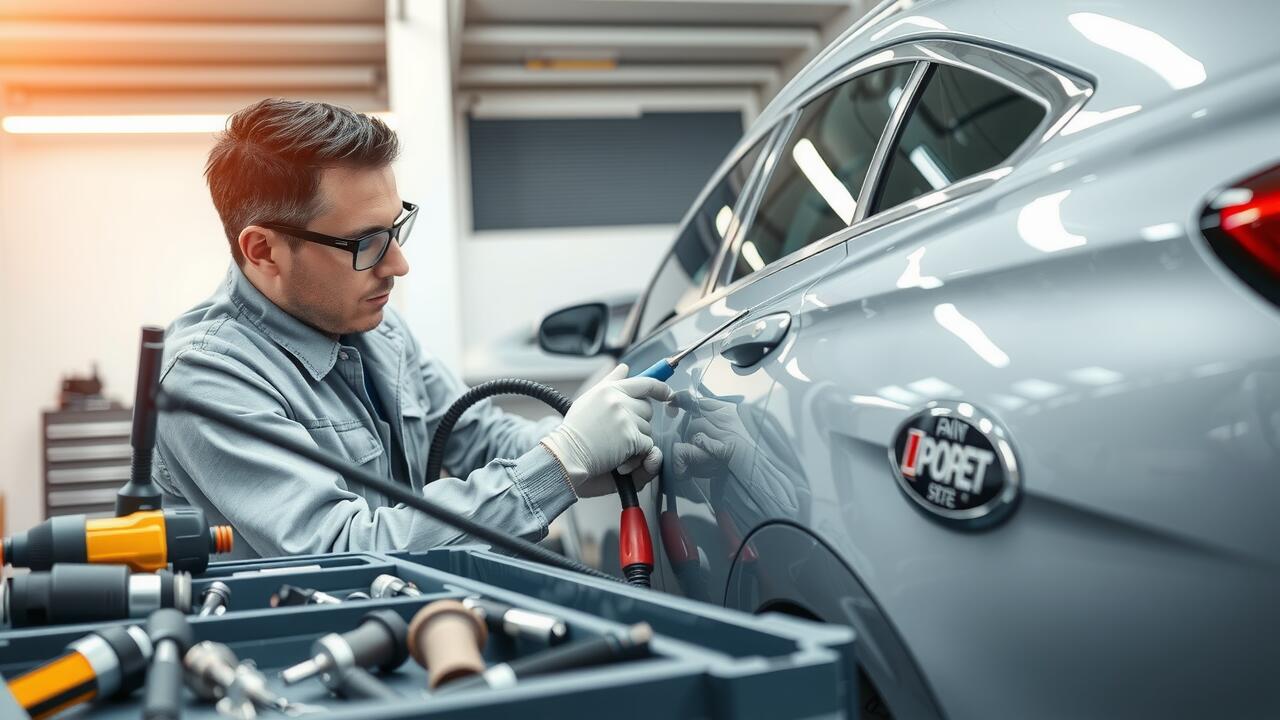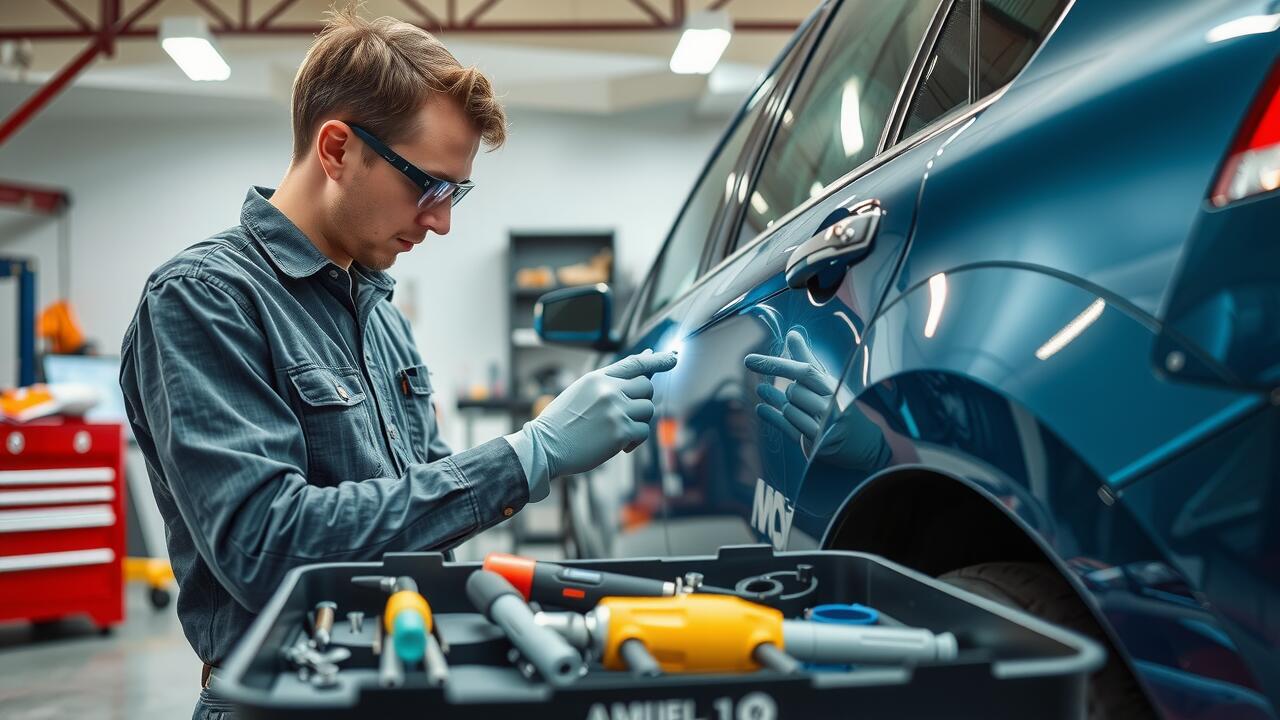
Tools Used in the Process
Paintless Dent Repair relies on a specific set of tools engineered to manipulate metal surfaces without compromising the paint finish. Essential tools include specialized rods and picks that are used to apply precise pressure on the dented area from behind the panel. These tools come in various sizes and shapes to accommodate different types of dents, ensuring that technicians can effectively reach and repair areas that are difficult to access. Additionally, most technicians utilize a light board or reflection board to improve visibility and guide their work as they meticulously reshape the damaged metal.
Apart from the main tools, some technicians might also use dollies to support the metal while pushing out the dent. Heat sources, such as a heat gun, can be utilized to soften the paint and metal, making the repair process smoother. A good understanding of the car's anatomy is crucial, as paintless dent repair requires skilled hands to restore the vehicle to its original condition without leaving any trace of the repair work. Each tool in this process plays a critical role in ensuring a successful outcome while maintaining the integrity of the car's finish.
Essential Equipment Overview
Paintless Dent Repair relies on a specific set of tools designed to manipulate metal from behind the damaged surface. These tools often include a variety of rods and picks, allowing technicians to gently massage the dent back into shape without compromising the vehicle’s original finish. Each tool serves a distinct purpose, enabling repair specialists to tackle different types of dents and access various sections of the vehicle.
In addition to the rods and picks, specialized lighting equipment is essential for assessing the damage accurately. This lighting helps reveal imperfections that might not be immediately visible under normal circumstances. High-quality lighting ensures that the technician can see the contours of the metal and align their tools effectively during the Paintless Dent Repair process, leading to optimal results and a smoother finish.
Step-by-Step Repair Process
The step-by-step repair process of Paintless Dent Repair begins with a thorough inspection of the damaged area. Technicians assess the size, depth, and location of the dent while considering factors such as the vehicle's make and model. This evaluation is crucial for determining the best approach for the repair. Once the technician has a clear understanding, they prepare the necessary tools and workspace to ensure efficiency and safety throughout the process.
Next, the technician gently manipulates the metal surface from behind the panel, using specialized tools designed to push out the dent. Careful attention is given to the pressure applied, as too much force can cause further damage. The goal is to restore the original contour of the vehicle without compromising the paint finish. Throughout the process, the technician monitors progress closely, ensuring that each step moves the repair closer to completion.
What to Expect During Treatment
During Paintless Dent Repair, the technician examines the damage and determines the best approach for the procedure. This initial assessment can take a short amount of time as they look for the size, location, and type of dent. After this evaluation, the technician will position their tools to begin manipulating the metal back to its original shape. Clients can expect the repair process to be quick, often completed within the same day for most minor dents.
Throughout the treatment, clients may hear various sounds as tools are applied to the vehicle’s surface. These noises are a normal part of the process and indicate that the technician is adjusting the metal. Skilled professionals utilize methods that minimize any risk of damage to the paint, ensuring that the vehicle retains its original finish. The end result should be a nearly flawless restoration of the vehicle's exterior, making Paintless Dent Repair an appealing option for many car owners.
Professional vs. DIY Methods
The debate between professional and DIY methods for Paintless Dent Repair often hinges on skill level and experience. Professionals typically have extensive training and access to advanced tools, enabling them to manage various types of dents effectively. Their familiarity with the techniques and materials enhances the likelihood of a flawless finish, making it a reliable option for serious damage or larger dents.
On the other hand, DIY approaches appeal to those looking to save money or attempt minor repairs independently. Various online tutorials and kits are available, allowing car owners to tackle small dents at home. Although a DIY method might be successful for minor imperfections, it carries the risk of causing additional damage if not executed correctly.
Comparing Approaches and Outcomes
When examining the effectiveness of professional versus DIY methods for dent removal, several factors come into play. Professional services, such as Paintless Dent Repair, utilize advanced techniques and specialized tools that ensure a high level of precision. Technicians are trained to assess the damage accurately, making it easier to determine whether the dent can be fully restored. Their experience allows them to avoid potential pitfalls that novices might encounter, leading to a more satisfactory end result.
On the other hand, DIY methods can provide a cost-effective alternative for those willing to put in the time and effort. Many people turn to tutorials online to learn basic techniques for dent removal. However, without access to professional-grade equipment and materials, the outcomes can be inconsistent. While some may achieve satisfactory results with DIY methods, the risk of potential damage to the vehicle's paint or structure often outweighs the benefits. Using Paintless Dent Repair through a professional service generally yields more reliable and long-lasting results.
FAQS
What size dents can paintless dent removal fix?
Paintless dent removal can typically fix dents that are up to about 2-3 inches in diameter, depending on the depth and location of the dent.
Can paintless dent removal fix deep dents?
Paintless dent removal is most effective for shallow dents. Deep dents may require additional methods, as they can cause damage to the paint or underlying structure.
Are there specific locations on a car where paintless dent removal works best?
Yes, paintless dent removal works best on areas with flat surfaces, such as hoods, doors, and fenders. It may be less effective on curved or complex shapes.
How does the condition of the paint affect paintless dent removal?
The paint must be intact and not cracked or chipped for paintless dent removal to be effective. If the paint is damaged, repair may be necessary before the dent can be removed.
Can I attempt paintless dent removal on my own?
While DIY methods are available, professional services are recommended for the best results, especially for larger or more complex dents. Professionals have specialized tools and experience to handle various types of dents.

